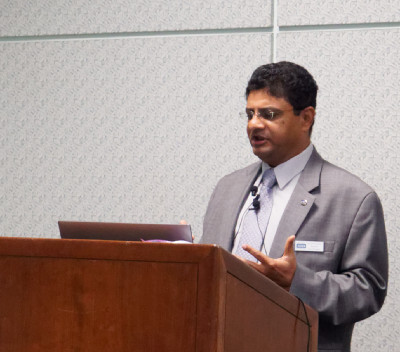 Our week at the SID exhibition, after the press conference, started with the annual SID Press breakfast when Sri Peruvembra, who looks after marketing for the SID, gave an update. One of the topics under discussion was the choice of venue for the 2017 SID. The event had originally been planned for San Jose, but the convention centre there decided to unilaterally cancel the SID’s booking. Although it paid a penalty, that meant that the SID had to find a new venue. There had been concern that moving away from Silicon Valley would mean a decline in attendance, but that hadn’t happened and delegate bookings were up on 2016 at above 7,000 and 500 more than last year’s.
Our week at the SID exhibition, after the press conference, started with the annual SID Press breakfast when Sri Peruvembra, who looks after marketing for the SID, gave an update. One of the topics under discussion was the choice of venue for the 2017 SID. The event had originally been planned for San Jose, but the convention centre there decided to unilaterally cancel the SID’s booking. Although it paid a penalty, that meant that the SID had to find a new venue. There had been concern that moving away from Silicon Valley would mean a decline in attendance, but that hadn’t happened and delegate bookings were up on 2016 at above 7,000 and 500 more than last year’s.
Sadly, the 2018 event had been booked for the Moscone Center in San Francisco, but, again, the venue decided to cancel, to undergo some upgrades, so once again, the event will be in Los Angeles. It’s not the most attractive venue, we think, but it is functional and is reasonably easily accessible from Asia – a critical factor in venue choice.
There are over 200 exhibitors this year and the IZone (where start-ups can show innovations for free) had 65 applications, up from just over 20 last year. 50 companies were accepted this year. One of the special events this year was a celebration of 30 years of OLEDs – which highlights how long it takes to establish a new display technology! We didn’t have time to fit that into our schedule, unfortunately. There were 15% more papers this year and in a separate interview, Peruvembra highlighted to us the work he is doing to boost the membership of SID by women. At the moment, the proportion of female members is below the level of the overall technology business and he is on a mission to correct this.
The SID is doing well, with 5,000 members in 28 chapters. There is a new student chapter at Stanford University, in Palo Alto, and membership in China has been growing, and the Beijing chapter is almost bigger than the Bay Area chapter – it will probably be the biggest quite soon. This year, SID worked with local colleges to allow students to attend the exhibition. Normally, students are not allowed to attend, but Peruvembra said that encouraging students that are already studying technology would increase the probability that they might see the display industry as a viable career option.
The other interesting possibilities that may influence the SID are the thoughts that new panel fabs may be built in India and even in the US.
Keynote 1 – Peng Summarises the Warring States Era of Display Technologies.
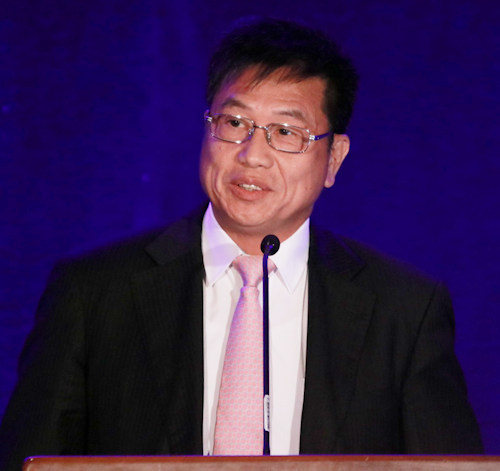 Paul Peng of AUO gave the first keynote which was built around periods in Chinese history, the best way to learn about the past, but that also shows the present and the future, when “The Empire, long divided, must unite; long united, must divide”. China has changed its territory many times under different dynasties. A large state may be more powerful but sometimes a small state is stronger. The rise and fall of Chinese territorial domination was influenced by internal and external factors.
Paul Peng of AUO gave the first keynote which was built around periods in Chinese history, the best way to learn about the past, but that also shows the present and the future, when “The Empire, long divided, must unite; long united, must divide”. China has changed its territory many times under different dynasties. A large state may be more powerful but sometimes a small state is stronger. The rise and fall of Chinese territorial domination was influenced by internal and external factors.
Display evolution started from CRT to flat panel displays, including PDP, LCD and EPD – and Peng called that “the first warring period”. Eventually LCD became dominant – in notebooks, then monitors, TVs and smartphones.
He said that changes now put the user at the centre – in the IoT world of the future, displays will be everywhere – displays are increasingly being introduced in transport, factories etc. At CES there were lots of displays in TV, VR and gaming. These applications all need immersive and lifelike viewing. High resolution is being developed up to 8K, HDR and motion artifact-free and blur-free HFR to show better motion are on the way. Of course, there are still challenges; in automotive applications, the required temperature range is a challenge; in smartphones, better performance in sunlight is needed; many applications should have lower power consumption.
The integrated displays in autos and equipment may need to last for up to 10 years or more, so service life is important. Environmental issues don’t just affect polar bears, Peng said, displays need to use less power and recycling at the end of life is also an important consideration.
Peng believes that TFT LCD will continue to maintain its ‘leading edge’. Peng highlighted its ‘true to life colour’ – the combination of QDs with optimised colour filters means good colour and high contrast ratio even in high ambient light. LCD has good performance in those conditions – users don’t watch in dark, he said. PS-VA LCD technology is better than IPS or OLED in these conditions
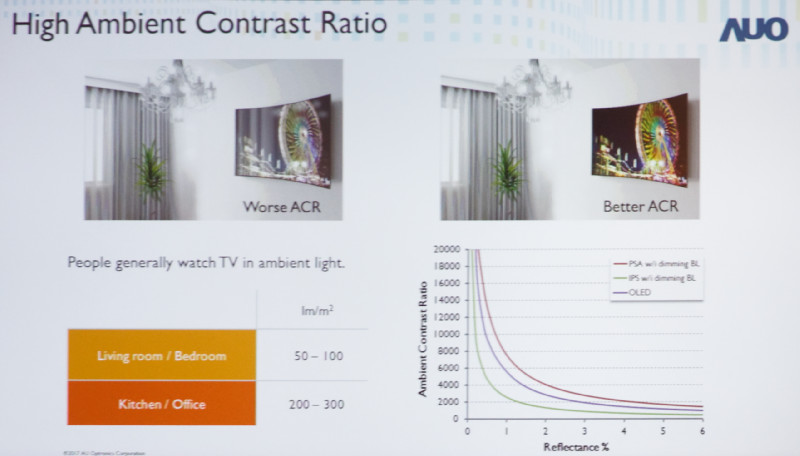 Peng said that PS-VA has better performance than OLED or IPS LCD in high ambient conditions.
Peng said that PS-VA has better performance than OLED or IPS LCD in high ambient conditions.
HDR is important and even makes a visible difference in high ambient light and Peng quoted a TV shoot out event in the UK as evidence.
LCD is competitive in premium TVs and looking back at CES, every year or two there have been new features, form factors and better image quality. This brings value to brands and better value for consumers. Looking at the long term value, in 2006 on Black Friday, for $999 a consumer could buy a 42″ HD LCD TV with a CCFL backlight. By 2016, for $1,099, the consumer could buy and LED-based UltraHD 65″ set with narrow bezels, curved and with HDR – an impressive boost in value. A 65″ OLED, however, would have cost $2,800 and without the curved feature.
Automotive is a tough market, there are difficult conditions to pass and it takes a long time to get approval. LCD has done this – with high brightness, wide temperature ranges and long lifetime – as much as 50,000 hours.ed
New display systems and apps can help automotive fuel efficiency and improve safety by replacing wing and rear-view mirrors. Fast response LCDs are needed for these applications and buyers also want stylish features. Curved displays are now available to automotive makers.
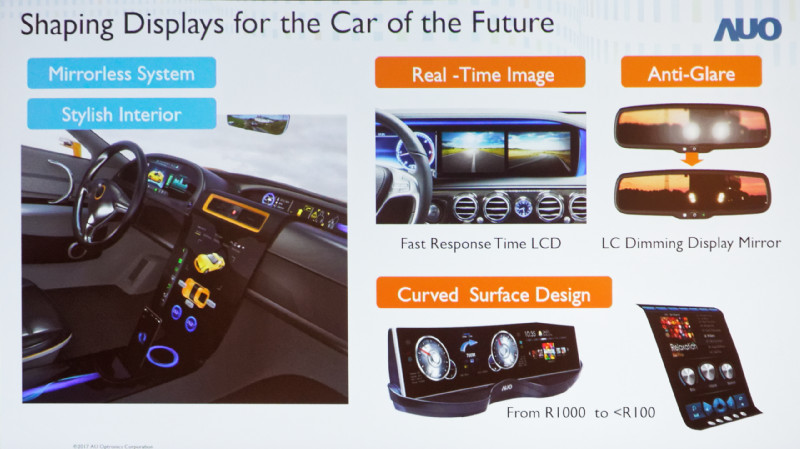 AUO said that automotive applications have special requirements
AUO said that automotive applications have special requirements
Peng said that there is a high degree of freedom to optimise LCDs in the choice of the LC material, in the array and in the BLU and filter to optimise the display for different applications. There has been relentless innovation – image quality has improved with QDs and local dimming. The next step is to put the QD in place of the colour filter for better performance. Going filter free in LCDs can mean up to 70% transparency, Peng said (although JDI had better than this on the show floor!)
Beyond LCD, OLED is being adopted for mobile devices – and is being developed to be both flexible and, eventually, rollable. To achieve fully flexible devices. there needs to be supply chain collaboration in the PCB, batteries and chips as well as the displays. Price needs to be pushed down, Peng believes.
OLED is good for wearables and smartwatches and it’s also good for VR. Circular shapers are popular for stylish watches, and there is a demand for slim bezels for fashion brands.
MicroLED has wide colour gamut, high brightness, low power, and can be curved – but many factors need to be improved so continuous investment and development is going to be needed. Peng believes that microLED is most likely to be applied to signage and wearables in the short term and in long term might come to automotive.
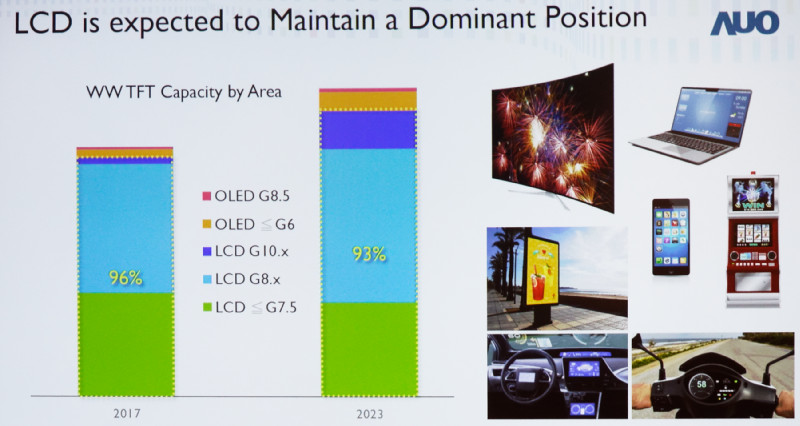
Up to 2023, LCD will remain over 90% of all flat panel by area – it remains the key technology for displays. Greener manufacturing is needed and will be an advantage for LCD. OLED uses 1.3 times the amount of water and power is almost double compared to LCD. Going to flexible increases the use of resources again. Waste water from LCD can be re-cycled, but it’s hard for OLED to re-cycle. That could mean more pollution when OLED scale goes up.
LCD display has a longer lifetime, both the display panel and the BLU and its possible to just replace BLU, if you choose.
In conclusion, Peng said, AUO continues to innovate in LCD in many areas – but especially in the green area.
Gping back to the opening concept of warring states – LCD based on amorphous silicon continues to fight with LTPS LCD and AMOLED, but will remain dominant. There is still a high risk of not making a profit for display makers by going to alternatives. The question is which of the competitors will win?
Peng believes it will be Darwininian and will mean the survival of the fittest!*
Analyst Comment
*Although, of course, Darwin said that survival goes to the organism that adapts best to its environment. (BR)

